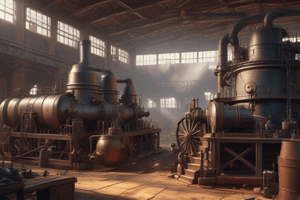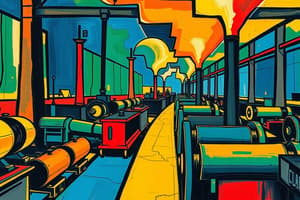Podcast
Questions and Answers
Which of the following most accurately compares handmade products with mass-produced products?
Which of the following most accurately compares handmade products with mass-produced products?
- Handmade products are always of higher quality than mass-produced products.
- Mass-produced products are always cheaper than handmade products.
- Handmade products are made quickly by machines. Mass products are made slowly by skilled workers.
- Handmade products are made slowly by skilled workers. Mass products are made quickly by machines. (correct)
During the second industrial revolution, which system of production dominated in factories?
During the second industrial revolution, which system of production dominated in factories?
- A system that limits the use of machinery.
- A system where each product is made individually by hand.
- A system in which products were made rapidly by machines. (correct)
- A system focused on quality over quantity.
The system of large amounts of products produced rapidly by machines is called?
The system of large amounts of products produced rapidly by machines is called?
mass production
What is one way that the system of mass production generally affected families?
What is one way that the system of mass production generally affected families?
The system of mass production in manufacturing developed rapidly
The system of mass production in manufacturing developed rapidly
During the Gilded Age, people who worked in factories?
During the Gilded Age, people who worked in factories?
As a result of the system of mass production, the majority of factory owners?
As a result of the system of mass production, the majority of factory owners?
How did Jan Matzeliger change the shoemaking industry in the 1800s?
How did Jan Matzeliger change the shoemaking industry in the 1800s?
As the economy grew during the Gilded Age, many workers and their families?
As the economy grew during the Gilded Age, many workers and their families?
Which of the following characterizes the role of women during the Gilded Age?
Which of the following characterizes the role of women during the Gilded Age?
Study Notes
Handmade vs. Mass-Produced Products
- Handmade products are crafted slowly by skilled artisans, focusing on quality and detail.
- Mass-produced products are manufactured quickly using machines, emphasizing efficiency and volume.
Production Systems in Factories
- The second industrial revolution saw rapid machine-based production dominating factories, enhancing output capabilities.
- Mass production refers to the large-scale manufacturing of products at a fast pace, primarily through mechanization.
Impact on Family Dynamics
- The mass production system shifted work from home settings to factories, altering traditional family structures and dynamics.
Historical Context of Mass Production
- Mass production gained significant momentum during the Gilded Age, a period marked by industrial expansion and economic growth.
Factory Work Conditions
- Workers in factories during the Gilded Age faced long working hours and grueling labor conditions, contributing to widespread fatigue and dissatisfaction.
Workforce Changes
- Factory owners increasingly replaced skilled workers with unskilled laborers due to the demands of mass production, impacting job quality and worker skills.
Innovations in Industry
- Jan Matzeliger revolutionized the shoemaking industry in the 1800s by inventing the lasting machine, which streamlined the process of attaching shoe tops to soles.
Economic Disparities
- Despite economic growth in the Gilded Age, many workers and their families struggled with low incomes and were unable to break free from poverty.
Women's Roles in the Gilded Age
- Many women during this period juggled multiple jobs alongside their domestic responsibilities, highlighting their contributions to both the workforce and household management.
Studying That Suits You
Use AI to generate personalized quizzes and flashcards to suit your learning preferences.
Description
This quiz explores the differences between handmade and mass-produced products, focusing on their impacts on family dynamics and work conditions. It also delves into the historical context of mass production during the Gilded Age and its influence on factory work systems.




